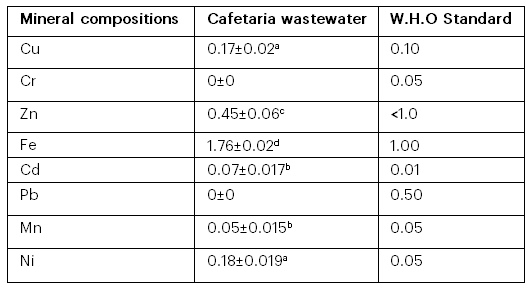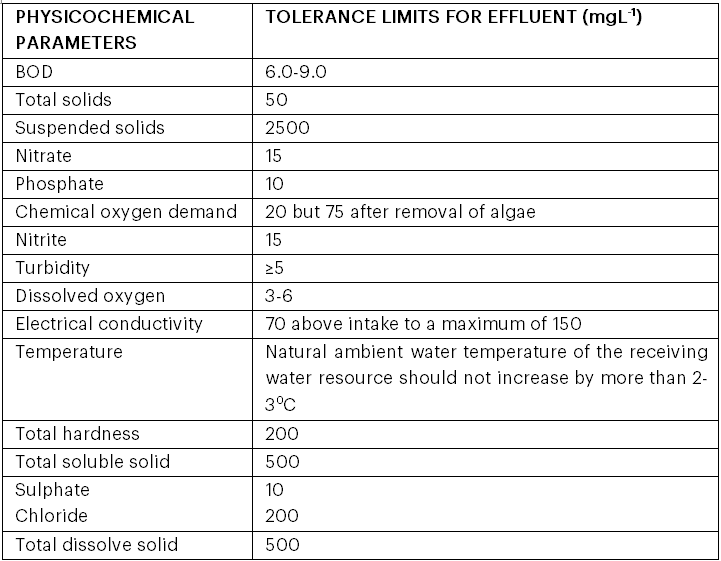Balogun, O. B.;1 Ayo, O. E.;2 & Bamigboye, O. J.3
1Department of Biological Sciences, Joseph Ayo Babalola University, Ikeji-Arakeji, Osun State, Nigeria
Corresponding Author Email:akinterinwatomilayo@yahoo.com
Abstract
The increasing student population at Joseph Ayo Babalola University (JABU) has resulted in significant wastewater discharge, which may harm local ecosystems. Despite the growing volume of effluent, little attention has been paid to its microbial and physicochemical characteristics. This study investigated the microbial and physicochemical properties of wastewater from the university cafeteria. The bacterial isolates identified included Aeromonas spp., Alcaligenes spp., Bacillus subtilis, Citrobacter spp., Escherichia coli, Enterobacter aerogenes, Klebsiella spp., and Micrococcus luteus. The fungal isolates identified were Aspergillus flavus, Aspergillus niger, and Penicillium italicum. The bacterial count (98.3 ± 7.09 cfu/ml) was higher than the fungal count (51.33 ± 4.16 cfu/ml). Physicochemical analysis revealed a temperature of 27 ± 0°C, colour of 18.83 ± 0.29 Pt/Co, turbidity of 8.5 ± 0 NTU, and conductivity of 39 ± 0 NTU. The highest values were recorded for total hardness (990 ± 0.3 mg/l), total solids (154 ± 0.3 mg/l), and total soluble solids (72.5 ± 2 mg/l), whereas dissolved oxygen (3.4 ± 0.05 mg/l) and total acidity (6.01 ± 0.5 mg/l) were the lowest. Among minerals, iron (1.75 ± 0.02 mg/l), zinc (0.45 ± 0.06 mg/l), and nickel (0.18 ± 0.019 mg/l) had the highest concentrations. The elevated microbial counts and certain physicochemical and mineral parameters pose potential health risks to the university community. The study recommends that the university implement monitoring strategies and proper wastewater treatment before effluent is discharged into the environment to prevent public and environmental health hazards.
Keywords: Wastewater quality, microbial contamination, physicochemical properties, environmental impact, and public health risk.
1. Introduction
Wastewater provides a suitable environment for the growth of various microorganisms, including protozoa, algae, fungi, yeasts, bacteria, and viruses. Bacteria such as Salmonella spp., Escherichia spp., and Pseudomonas spp.; fungi such as Candida spp., Aspergillus spp., and Penicillium spp.; and viruses such as Norovirus, Adenovirus, and Rotavirus are commonly found in wastewater. The composition of wastewater, which is rich in organic nutrients (e.g., organic nitrogen, humic compounds and carbohydrates such as sucrose and fructose), supports the proliferation and metabolic activities of these microorganisms (Balogun et al., 2019). Bacteria play a significant role in the decomposition of organic matter, including the bioremediation of oil spills, degradation of organic pollutants, plastics, synthetic polymers, agricultural waste, and nutrient cycling. The microbial composition of wastewater changes over time as decomposition progresses.
The world is facing unprecedented challenges in managing wastewater, with billions of people lacking access to adequate sanitation and treatment facilities (Adams, 1994). Inadequate treatment of wastewater effluent can pose public health risks, especially in areas where untreated effluent is discharged into the environment (Adefemi & Awokunmi, 2010). Pollution from wastewater is currently one of the greatest risks to the sustainable use of groundwater and surface water (Eniola et al., 2021; Adekunle et al., 2004). Discharged wastewater may contain toxic substances, pathogenic microorganisms, and chemical pollutants that can cause adverse environmental impacts, including reduced biodiversity, altered species composition, and contamination of drinking and recreational water (Banu & Menakuru, 2010). Untreated cafeteria wastewater in university settings poses serious risks by contaminating nearby waterways and soil, potentially affecting plant growth and human health through waterborne diseases such as cholera, typhoid and dysentery (Eniola et al., 2021). Recognising and addressing these risks is essential to safeguarding the health and safety of university communities.
Chemical pollutants also pose risks. The effects of inorganic chemicals are well documented compared to those of trace organic chemicals found in groundwater (Adams, 1994). For example, organic pesticides (e.g., DDT, organophosphates) can lead to health issues such as cancer and neurological disorders, while persistent organic pollutants (POPs) may bioaccumulate and biomagnify through the food chain. Common groundwater contaminants include hydrocarbons, metals, cyanide, arsenic, synthetic substances, soluble forms of nitrogen and phosphorus, and organic matter (Arku et al., 2011). In Nigeria, wastewater treatment technologies remain underdeveloped, particularly for small-scale effluent sources such as university cafeterias. In the United States, activated sludge systems are widely used for secondary treatment, with advanced oxidation processes (AOPs), ultraviolet (UV) disinfection and membrane filtration for tertiary treatment. European countries also employ activated sludge and trickling filters for secondary treatment; Germany and the Netherlands use advanced tertiary systems, including membrane bioreactors (MBRs) and ozone-based treatments. Consequently, wastewater is often discharged untreated or inadequately treated, increasing the risk of pollution and the proliferation of harmful microorganisms. Joseph Ayo Babalola University (JABU) in Osun State, Nigeria, is situated in a region with surrounding water bodies. This research focuses on the microbial and physicochemical analysis of wastewater effluent from the university cafeteria, highlighting local trends and challenges and recommending improvements to promote sustainability and resource conservation.
2. Material and Methodology
2.1 Study Area
Wastewater samples were collected from the cafeteria at Joseph Ayo Babalola University, located in Ikeji-Arakeji, Oriade Local Government Area, Osun State, Nigeria. The region lies within the Yoruba Hills, which extend from Ijesa Land in Osun State to Ekiti and Ondo States. The Yoruba Hills are critical to the regional hydrological system, often serving as the source of rivers and streams that support human settlements and agriculture. Discharge of wastewater into these water sources can lead to pollution. The area experiences a tropical dry and wet climate, with temperatures typically ranging from 22°C to 32°C (72°F to 90°F).
2.2 Sample Collection and Microbial Isolation
Effluent samples were collected from the cafeteria’s wastewater discharge system. Weekly samples were taken to evaluate seasonal or weekly fluctuations in wastewater quality. Samples were analysed for microbial content using standard microbiological techniques. Selective media for bacterial isolation included nutrient agar, eosin methylene blue agar, mannitol salt agar and MacConkey agar, while potato dextrose agar was used for fungal isolation. All microbial isolations were performed in triplicate.
2.3 Isolation and Identification of Bacterial and Fungal Isolates
Bacterial isolates were cultured using the pour plate method with serial dilutions, followed by incubation at 37°C for 24 hours. Pure cultures were obtained through repeated subculturing. Identification was based on colony morphology, cell morphology, Gram staining, and biochemical tests (e.g., sugar fermentation, citrate utilisation, catalase, indole production, and motility tests) (Cheesbrough, 2006).
Fungi were isolated using the pour plate method on potato dextrose agar (PDA), and pure cultures were obtained by subculturing. Identification was based on colonial appearance and microscopic observation (Baron & Sydney, 1990).
2.7 Physicochemical Analysis
Physicochemical properties, including pH, electrical conductivity, total solids, suspended solids, dissolved solids and sulphate concentration, were analysed using standard laboratory methods (APHA, 2022). pH was measured using a Thermo Scientific Orion Star A111 pH benchtop meter, and conductivity was determined using a Thermo Scientific Orion Star A220 EC metre. Metal concentrations (e.g., iron, zinc, nickel) were determined using atomic absorption spectrometry (AAS).
Statistical analysis was performed using one-way ANOVA in SPSS (version 16.0) to compare the log-transformed CFU values (p ≤ .05) obtained during the sampling periods.
3. Results and Discussion
Microbial Analysis of Wastewater from Joseph Ayo Babalola University Cafeteria
The bacterial isolates identified in the wastewater effluent included Aeromonas spp., Alcaligenes spp., Bacillus subtilis, Citrobacter spp., Escherichia coli, Enterobacter aerogenes, Klebsiella spp., and Micrococcus luteus. Escherichia coli (E. coli) and Klebsiella spp. are both Gram-negative bacteria that can be pathogenic to humans, with the potential to cause a variety of infections. Fungal isolates included Aspergillus flavus, Aspergillus niger, and Penicillium italicum. The total bacterial count (98.3 ± 7.09 cfu/ml) was significantly higher than the fungal count (51.33 ± 4.16 cfu/ml), indicating a bacterial-dominated microbial load in the wastewater (see Tables 1 and 2).
The total bacterial load was within permissible limits. Figure 1 indicates that total dissolved solids (TDS) and total suspended solids (TSS) were below WHO standards, whereas total hardness exceeded WHO standards. Most other physicochemical parameters were below the standards (see Table 3). Table 4 shows that all mineral compositions, except for iron and nickel, fell below the acceptable limits.
Table 1: Colonial, Microscopy and Biochemical Characteristics of Bacteria Isolated from Wastewater Generated by Joseph Ayo Babalola University Cafeteria

Key: Mo = Motility; Cat = Catalase; Ox = Oxidase; MR = Methyl Red; VP = Voges–Proskauer; Glu = Glucose; Lac = Lactose; EMB = Eosin Methylene Blue; Ci = Citrate; Ur = Urea; –R = Gram-negative rod; +R = Gram-positive rod; –C = Gram-negative cocci; +C = Gram-positive cocci; –, Negative reaction; +, Positive reaction; N = Not done.
Table 2: Cultural and Microscopy Characteristics of Fungal Isolates from Wastewater Generated by Joseph Ayo Babalola University Cafeteria


Figure 1: Total Microbial Counts of Wastewater from Joseph Ayo Babalola University Cafeteria
Table 3: Physicochemical Properties of Water Effluent from Joseph Ayo Babalola University Cafeteria

Key: T hardness = Total hardness; T solid = Total solids; TDS = Total dissolved solids; TSS = Total soluble solids; DO = Dissolved oxygen; BOD = Biological oxygen demand; COD = Chemical oxygen demand.
Table 4: Mineral Composition of Wastewater from Joseph Ayo Babalola University Cafeteria

Table 5: Tolerance Limits of Physicochemical Parameters for Effluent (mg/L)

4. Discussion
The microbiological characteristics of the wastewater revealed a predominance of Gram‐negative and Gram‐positive bacteria, including Aeromonas spp., Alcaligenes spp., Bacillus subtilis, Citrobacter spp., Escherichia coli, Enterobacter aerogenes, Klebsiella spp., and Micrococcus luteus. The presence of coliform bacteria, particularly E. coli, serves as an indicator of faecal contamination in the effluent, highlighting the potential presence of pathogenic organisms that could pose significant public health risks (Balogun et al., 2016). The dominance of Gram‐negative bacteria such as Escherichia coli and Klebsiella spp. in wastewater underscores the public health risks associated with water contamination. These bacteria are often pathogenic, can contribute to the spread of antimicrobial resistance, and are particularly concerning in environmental settings where improper wastewater treatment may lead to the contamination of drinking water and agricultural sources.
Fecal contamination of water sources—whether through direct human contact or the release of untreated wastewater—poses a substantial risk of transmitting diseases such as gastrointestinal infections, urinary tract infections, meningitis, and severe foodborne illnesses. Inadequate wastewater treatment systems exacerbate the spread of E. coli and other pathogens by allowing these organisms to persist in the environment and potentially contaminate drinking water, recreational water, and food sources.
The mean bacterial count (98.3 ± 7.09 CFU/mL) was notably higher than the fungal count (51.33 ± 4.16 CFU/mL), suggesting a predominantly bacterial contamination in the wastewater. Among the bacterial isolates, Bacillus subtilis was of particular interest owing to its association with foodborne illnesses, including emetic and diarrhoeal diseases. Akonai (2005) reported that approximately 27,000 cases of foodborne illnesses annually are attributed to Bacillus species, which are capable of producing toxins that may affect human health (Balogun et al., 2019).
The presence of E. coli in the wastewater could be linked to the use of animal manure in cultivating vegetables around the university. Livestock and agricultural activities are major contributors to E. coli contamination in water systems. Cattle, poultry, and other livestock harbour significant amounts of E. coli in their digestive systems, which can then be introduced into the environment through manure runoff or direct exposure to water bodies. Furthermore, septic systems are commonly used for wastewater treatment in rural or underdeveloped areas. If these systems are not properly maintained, E. coli can leach from septic tanks and drain fields, contaminating nearby surface waters or groundwater. Improperly designed or overburdened septic systems may overflow during periods of heavy rain or high usage, leading to the direct release of untreated waste containing E. coli into the environment. E. coli is notorious for causing gastrointestinal diseases, and its resistance to antibiotics renders treatment of infections challenging (Close et al., 2008).
The presence of Aeromonas spp., Alcaligenes spp. and Bacillus subtilis may be due to improper cleaning or water contamination, as reported by Oluwanishola et al. (2019), who observed similar bacterial species. Furthermore, water used in food preparation, cleaning, or dishwashing that is contaminated with Alcaligenes spp., Bacillus subtilis and Aeromonas spp. could contribute to their presence in the cafeteria. Additionally, if wastewater comes into contact with unsanitary surfaces or if cross‐contamination occurs, these bacteria may be introduced into the environment. This can lead to public health concerns if there is no proper storage of wastewater from the cafeteria.
Fungal infections, especially those associated with wastewater, may cause health concerns because they can lead to gastrointestinal issues. Fungal genera isolated from the wastewater included Aspergillus flavus, Aspergillus niger, and Penicillium italicum. These fungi are known to cause diseases in humans and animals, such as respiratory infections and allergic reactions, possibly due to poor handling during food preparation in the cafeteria. The coexistence of bacteria and fungi in the effluent highlights the complex microbial interactions that can range from neutral to beneficial. Such microbial dynamics may play a role in biodegradation processes within the effluent, but they also pose challenges to water treatment efforts (Banu & Menakuru, 2010).
A university campus such as JABU hosts a large and diverse population of students, faculty, and staff, all of whom interact in various shared spaces such as dormitories, classrooms, cafeterias, and recreational areas. These environments can be breeding grounds for environmental and public health concerns, including microbial contamination, air and water quality issues, and foodborne illnesses. With a concentrated population, even small‐scale issues can escalate quickly, leading to significant public health risks (Balogun et al., 2019). Microorganisms isolated from the wastewater can cause foodborne illnesses arising from water contamination, and poor sanitation can have widespread impacts on the university community, particularly if there are inadequate preventive measures.
Given these findings, it is crucial to implement proper wastewater treatment measures before discharge into the environment to reduce microbial contamination and mitigate associated health risks. In Nigeria, the National Environmental Standards and Regulations Enforcement Agency (NESREA) is tasked with overseeing environmental standards at the federal level, while state ministries of the environment have their respective task forces for monitoring and enforcing safe environmental practices. To prevent microbial contamination in wastewater, multi‐stage treatment processes are critical. These processes include primary, secondary, and tertiary treatment technologies, with disinfection methods (e.g., UV, electromagnetic field, chlorination, or ozonation) playing a vital role in pathogen removal. Furthermore, natural solutions such as constructed wetlands can help address contaminants from agricultural runoff and wildlife, while membrane bioreactors provide an advanced option for achieving high‐quality effluent. By utilising a combination of these methods, wastewater treatment plants can effectively reduce microbial contamination, thereby protecting public health and the environment.
The physicochemical analysis of the wastewater effluent revealed a pH of 6.42, which falls within the acceptable range for water (6–9). This finding is consistent with the results of Erah et al. (2002), who reported similar pH values in effluent studies. Although pH does not directly impact human health, it is a critical parameter for water treatment because extreme pH levels can affect the corrosivity of water and its interaction with distribution systems (Oluwasola et al., 2019). A pH of 6.42 may indicate the presence of organic matter or sewage, while a high pH (alkaline conditions) may be due to chemical waste, detergents, or cleaning agents—possibly those used when washing plates in the cafeteria.
The temperature of the effluent was 27°C, which aligns with the findings of Umoh and Etim (2013), who observed similar temperatures in preliminary studies on water characteristics. Temperature is a key factor affecting aquatic ecosystems, as it influences the metabolic rates of organisms and the solubility of gases such as oxygen. The dissolved oxygen (DO) concentration in the effluent was found to be 7.5 mg/L, which is higher than the recommended range of 3–6 mg/L for effluent discharge (Nigeria Standard for Drinking Water Quality, 2018). This value suggests that the effluent has a moderate level of oxygen available for aquatic life, although concentrations below 5 mg/L could harm organisms, especially those dependent on higher oxygen levels (NSDWQ, 2016).
Total dissolved solids (TDS) were measured at 154.5 ± 0.3 mg/L, which is below the WHO and EPA recommended maximum of 500 mg/L for effluents. Although TDS levels are within permissible limits, their composition and cumulative effects over time on various sectors must be considered carefully. Water management strategies should take these potential implications into account to safeguard human, agricultural, industrial, and ecological interests downstream (Adekunle et al., 2004). While TDS levels do not directly indicate a health risk, they can affect the taste of water (World Health Organization, 2023). High TDS concentrations, often due to salts, may be undesirable in drinking water and can reduce its palatability. The high level of TDS in JABU’s cafeteria may indicate that the campus is not efficiently filtering out contaminants from its wastewater system, thereby posing a risk for waterborne diseases and environmental degradation (World Health Organization, 2023).
The turbidity of the effluent was found to be 8.5 NTU, which exceeds the WHO and National Water Quality Standards recommendations, indicating a high level of suspended particles. Elevated turbidity can harbour microorganisms such as bacteria and parasites, increasing the potential for waterborne diseases (Emmanuel et al., 2009). High turbidity in water poses serious challenges for water quality and treatment processes, with significant implications for microbial attachment and waterborne disease transmission. It not only increases the risk of pathogens surviving in the water but also makes water treatment more difficult. The colour of the effluent, recorded at 18.8 Pt/Co, exceeds the WHO standard, further emphasising the level of pollution in the wastewater (World Health Organization, 2022). The presence of colour in water indicates the presence of organic matter in the wastewater, which can affect its aesthetic quality and is often indicative of pollution. This suggests organic pollution resulting from dishwashing in the cafeteria, with the contaminated water being released into the environment.
Conductivity, measured at 39 μS/cm, was lower than the expected 70 μS/cm. Although conductivity itself does not pose direct health risks, it is a measure of the water’s ionic content and can indicate the presence of pollutants or dissolved salts (World Health Organization, 2024). The presence of certain metals, such as iron, zinc and nickel, in concentrations higher than recommended levels suggests contamination resulting from organic pollution from activities in the cafeteria, which is consistent with the findings of Eniola et al. (2021).
The acidity level of the wastewater is an important parameter for determining its corrosive potential. It reflects the capacity of the water to neutralise a strong base and indicates the presence of weak organic acids or mineral acids, which can be harmful to aquatic life if present in excessive quantities. The wastewater was neutral at pH 7; at neutral pH, water neither exhibits acidic nor alkaline characteristics. However, even at neutral pH, interactions between materials in the wastewater system and the receiving environment can occur, with various implications for water quality, infrastructure and ecological health.
The high sulphate concentration (222 mg/L) points to contamination from detergents and soaps used in washing plates and pots (Oluwasola et al., 2019). Elevated sulphate levels in aquatic systems can have significant ecological implications, especially when concentrations exceed natural or baseline levels. Although sulphate is a naturally occurring compound, excess amounts—particularly from human activities such as industrial discharges, agricultural runoff, wastewater and mining operations—can disrupt the delicate balance of freshwater and marine ecosystems. These disruptions can lead to several ecological consequences, including eutrophication and other environmental stresses. Previous studies have also found high levels of detergents in wastewater samples. Chloride levels, measured at 6.42 mg/L, fell within acceptable limits for effluents according to EPA guidelines. The concentration of nitrates (6.8 ± 0.05 mg/L) was within the permissible limit set by WHO, suggesting that nitrogenous pollutants in the effluent were not excessively high.
The presence of heavy metals in wastewater from the cafeteria could pose a serious health risk to students and staff if it affects the water supply or contaminates food through irrigation with polluted water. This would require urgent remediation efforts from the school management.
5. Conclusion and Recommendations
The results of this study indicate that the wastewater from the cafeteria at Joseph Ayo Babalola University exhibits several physicochemical parameters that exceed the recommended limits for safe discharge into the environment. While certain parameters such as pH, temperature and some metal concentrations were within acceptable ranges, other parameters (including total solids and total soluble substances) were high (albeit still within permissible limits); however, colour and microbial contamination were not within acceptable limits. High COD and BOD values indicate the presence of organic material, which often carries pathogens. This suggests that the wastewater may contain faecal matter, food waste or other contaminants that could compromise public health, particularly in food preparation areas such as the cafeteria, especially when erosion occurs and the water reaches large water bodies, thereby causing environmental problems and public health issues.
These findings underline the need for proper wastewater treatment such as filtration or sedimentation within the university community before the effluent is discharged directly into the environment, in order to prevent potential public and environmental health hazards. The lack of existing monitoring systems for wastewater quality at the university calls for immediate policy action and heightened awareness regarding the importance of wastewater treatment and environmental protection. Continuous monitoring of wastewater parameters such as pH, BOD, COD, TSS and nutrient levels will help to identify problems early. In addition, implementing regular maintenance schedules for the cafeteria’s wastewater system is recommended.
References
Adams, C. E. (1994). The fish community of Loch Lomond, Scotland: Its history and rapidly changing status. Hydrobiologia, 290(3), 91–102.
Adefemi, S. O., & Awokunmi, E. E. (2010). Determination of physicochemical parameters and heavy metals in water samples from Itaogbolu area of Ondo State, Nigeria. African Journal of Environmental Science and Technology, 4(3), 145–148.
Adekunle, L. V., Sridhar, M. K. C., Ajayi, A. A., Oluwade, P. A., & Olawuyi, J. F. (2004). Assessment of the health and socio-economic implications of sachet water in Ibadan, Nigeria. African Journal of Biomedical Research, 7(1), 5–8.
Akonai, K. A. (2005). Distribution pattern of enteric organisms in the Lagos Lagoon. African Journal of Biomedical Research, 8(3), 163–188.
Arku, A. Y., Musa, S. M., Mofoke, A. L. E., & Dibal, J. M. (2011). Re-examining raw effluents from Nigerian Bottling Company Maiduguri for crop irrigation. Journal of Applied Phytotechnology Environmental Sanitation, 1(1), 43–49.
APHA. (2022). Standard methods for the examination of water and wastewater (20th ed.). American Public Health Association.
Balogun, O. B., Akinsuroju, M. O., & Oluwasola, P. O. (2019). Bacteriological analysis of selected industrial wastewater in Akure Metropolis. International Journal of Recent Innovations in Academic Research, 3(1), 228–236.
Balogun, O. B., Adeyemo-Eleyode, V., & Ekundayo, S. (2016). Comparative assessment of microbial populations in abandoned pond water and soil samples in Ikole-Ekiti Metropolis. In J. N. Ogbulie, D. J. Arotupin, A. A. Farouq, & E. J. Archibong (Eds.), Harnessing microbes for health and wealth (pp. 37). Kings University, Odeomu, Osun State: Ajidek Ltd.
Baron, E. J., & Sydney, M. F. (1990). Bailey and Scott’s diagnostic microbiology. Mosby.
Banu, N., & Menakuru, H. (2010). Enumeration of microbial contamination in school water: A public health challenge. Health, 2(6), 582–588.
Cheesbrough, M. (2006). District laboratory practice in tropical countries (2nd ed.). Cambridge University Press.
Close, M., Dann, R., Ball, A., Pirie, R., Savill, M., & Smith, Z. (2008). Microbial groundwater quality and its health implications for a border-strip irrigated dairy farm catchment, South Island, New Zealand. Journal of Water and Health, 6(1), 83–98.
Emmanuel, E., Pierre, M. G., & Perrodin, Y. (2009). Groundwater contamination by microbiological and chemical substances released from hospital wastewater: Health risk assessment for drinking water consumers. Environment International, 35, 718–726.
Eniola, K. I. T., Adeoye, V. B., Ajayi, O. O., & Balogun, O. B. (2021). Assessment of health risk of communal drinking water sources in Oyo Town, Southwest Nigeria. JABU Journal of Science and Technology, 5(3).
Erah, P. O., Akujieze, C. N., & Oteze, G. E. (2002). The quality of groundwater in Benin City: A baseline study on inorganic chemicals and microbial contaminants of health importance in boreholes and open wells. Tropical Journal of Pharmaceutical Research, 1(2), 75–82.
NSDWQ. (2016). Nigeria Standard for Drinking Water Quality. Nigeria Industrial Standard, Approved by the Standards Organisation of Nigeria Governing Council, (13), 15–19.
Oluwasola, P. O., Eniola, K. I. T., & Balogun, O. B. (2019). Response of bacteria isolated from a segment of River Owena to linear alkylbenzene sulfonate (LAS). International Journal of Health, Nursing and Medicine, 5(1), 1–9.
Umoh, S. D., & Etim, E. E. (2013). Determination of heavy metals content from dumpsites within Ikot Ekpene, Akwa Ibom State, Nigeria. International Journal of Engineering Science, 2(2), 123–129.
World Health Organization. (2022). Water and sanitation: Protection of the human environment. World Health Organization, Geneva, Switzerland, pp. 40–70.
World Health Organization. (2023). WHO guidelines for the safe use of wastewater, excreta and greywater: Excreta and greywater use in agriculture (pp. 60–90). World Health Organization, Geneva, Switzerland.
World Health Organization. (2024). WHO guidelines for the safe use of wastewater, excreta and greywater: Excreta and greywater use in agriculture (pp. 66–75). World Health Organization, Geneva, Switzerland.
About this Article
Cite this Article
APA
Balogun, O. B., Ayo, O. E., & Bamigboye, O. J. (2025). Comprehensive Microbial and Physicochemical Assessment of Wastewater from Joseph Ayo Babalola University Cafeteria, Osun State, Nigeria. In Akinyele B.J., Kayode R. & Akinsemolu A.A. (Eds.), Microbes, Mentorship, and Beyond: A Festschrift in Honour of Professor F.A. Akinyosoye. SustainE
Chicago
Balogun, O. B., Ayo, O. E., and Bamigboye, O. J. 2025. “Comprehensive Microbial and Physicochemical Assessment of Wastewater from Joseph Ayo Babalola University Cafeteria, Osun State, Nigeria” In Microbes, Mentorship, and Beyond: A Festschrift in Honour of Professor F.A. Akinyosoye, edited by Akinyele B.J., Kayode R. and Akinsemolu A.A., SustainE.
Received
15 December 2024
Accepted
10 January 2025
Published
4 February 2025
Corresponding Author Email: balogunlekan208@gmail.com
Disclaimer: The opinions and statements expressed in this article are the authors’ sole responsibility and do not necessarily reflect the viewpoints of their affiliated organizations, the publisher, the hosted journal, the editors, or the reviewers. Furthermore, any product evaluated in this article or claims made by its manufacturer are not guaranteed or endorsed by the publisher.
Distributed under Creative Commons CC-BY 4.0
Share this article
Use the buttons below to share the article on desired platforms.














